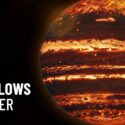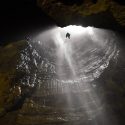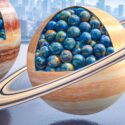Jupiter…. Uranus…. Saturn… Earth? Sadly, the Earth didn’t make it onto the list of the Solar System’s ringed planets. If it did, would it still be able to host life?

When the Earth was young, it most likely had a ring of rock debris around it. 4.5 billion years ago another planet, Theia, hit the Earth. The giant impact sent a ring of matter hurtling into the Earth’s orbit. But it didn’t stay like that for long. The rocky debris soon formed another celestial body – the one we now call the Moon.

Having planetary rings visible in the sky would look way more spectacular than just one grey rock, right? Maybe. But if our planet got beautiful rings like these tomorrow, much of life on Earth might not survive the renovation process.

The gravitational pull that our planet exerts on the Moon isn’t equal everywhere. It’s much stronger on the side of the Moon that is closer to us.

The distance of the Roche Limit depends on the size, mass and density of the two objects. For instance, the Sun rips up comets that come within 1.3 million km (0.8 million mi) of it. The Earth will tear apart an average-sized comet from approximately 18,000 km (11,185 mi) away. For the Moon, the Roche limit would be 9,500 km (5,900 mi).

The rings we might get from something the size of the Moon would be about 5,000 km (3,100 mi) wide and around 9.5 m (31 ft) thick.

But unlike Saturn’s icy rings, ours would be made of nothing but rock. The Earth is just too close to the Sun to keep the debris iced.

Looking out at the sky, you’d be able to see these rings from Earth at all times. Because of the brightness of the rings, the Moon wouldn’t seem as bright anymore. That is if we still had the Moon. If the Moon crumbled up and became our rings, well, there’d be nothing else up there to look at. And there would be some other consequences.

The rings suddenly hugging Earth would disrupt internal navigation systems of some animals. If not enough direct sunlight was making it through the rings, they would also affect photosynthesis and our oxygen supply.

In the shadow of the rings, with no contact from the Sun’s rays, the temperature would get so cold that it would make the shadowed areas of the Earth almost uninhabitable.

Communications satellites, generally placed around the Earth’s equator, would find themselves right in the middle of a rock storm. We’d need to find another way to keep the internet alive if we want to keep posting selfies on a ringed Earth.

We’d be better off in a scenario where the Earth has always been like this. Provided we didn’t lose sunlight and oxygen, we’d evolve just fine. But we’d have to develop other means of communication since we wouldn’t be able to send satellites into an orbit full of rocks.

Space would never become our final frontier. The rocky rings around the planet would be a sort of orbital barbed wire fence keeping us all grounded. And, just like the rings of Saturn, Earth’s rings wouldn’t last forever. One day they’d start to feel their age and drop from the sky.
Make sure to wear a helmet and look up at the falling sky. If the multiverse is real, there might be a ringed Earth somewhere out there, with people on it wondering what it’d be like to live on a planet with no rings.
This hypothetical view has of course been inspired by other posts on the interwebs. So we’d recommend to check out these more in-depth resources about the subject:
Sources
- Quantum Rocketry: A nifty thought experiment: the Earth with rings
- Bad Astronomy: What if Earth really did have rings?
- SciShow Space: Why Doesn’t Earth Have Rings?
- Gizmodo: What Life on Earth Would Look Like If Earth Had Rings Like Saturn
- Kevin Gill on Flickr: Rings over Earth



























